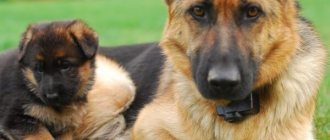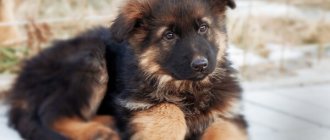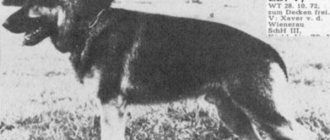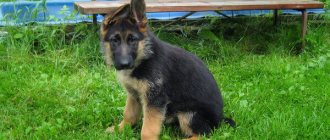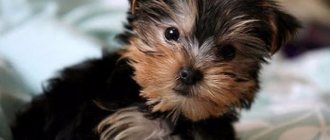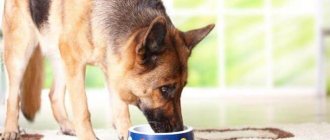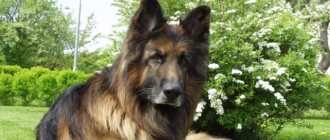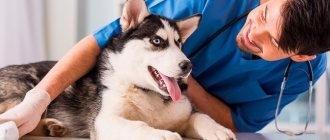The German Shepherd breed has long won the hearts of mankind.
They have all the qualities that a true friend needs.
Moreover, not a single patrolman or policeman can do without these dogs.
They are not only loyal friends, but also brave defenders who will do everything to save their owner.
So how do you choose a puppy?
Let's find out in detail from the article.
At what age are weaned from the mother?
Weaning too early can have a negative impact on the puppies' psyche . This moment must be timely, it must be chosen correctly.
Weaning should occur before the first vaccination . It is done at 2 months.
At 3-4 weeks, complementary foods are already introduced for puppies, which means that weaning from the mother should occur gradually by 5-6 weeks.
In order not to suddenly deprive the puppies of their mother's milk, it is allowed to let the puppies suckle at night. Over time, this too will have to be eliminated.
What you need to know before the inspection
Mixed labrador and shepherd dog, mongrel, husky and other breeds
Before examining the dog, you need to ask the seller how often the mother of the puppy gives birth. It is highly not recommended to take a baby if the dog gives birth on average more than once a year. Experience shows that dogs that bear offspring more than once a year are more likely to bear defective offspring.
The optimal number of puppies in a litter is no more than 10, otherwise the likelihood increases that a mother with many children simply does not have enough strength for high-quality gestation. It is also recommended to pay attention to the size of the puppies. They should have approximately the same condition, naturally taking into account the fact that males will always be larger than females.
What types of German Shepherds are there?
German There are several classifications to divide German Shepherds: by coat length, by color and by breeding line.
Types of German Shepherds by coat length:
- Short-haired. The coat of such shepherds is thick, short and close to the body. They have a good undercoat. The fur on the neck, tail and hips is longer than on the rest of the body;
- Long-haired. These dogs have soft, slightly wavy fur with an undercoat. The dog has a parting on its back. The especially thick coat on the neck and behind the ears, behind the ears and on the back of the paws forms feathering.
Crossing long-haired and short-haired shepherd dogs is prohibited . These are two different breeds, breeding records are kept separately.
Types of German Shepherds by color:
- Black. The rarest color for German Shepherds, only 5% have it. Black dogs of this breed are the real elite;
- Black and tan. The body is black, and the stomach and paws on the inside are light.
- Zonal. Each hair is colored in ring zones: light, then black, yellow, black.
- Black-and-white. The fur on the back is black, the belly, neck and limbs have tan markings of various colors: chocolate, reddish, yellow, fawn, gray. The muzzle is black or gray;
- White. A German Shepherd can be white if both parents have the recessive gene responsible for this color. In Canada, they even managed to develop a separate breed of such dogs.
The red color of the German Shepherd does not meet the standard, but this does not prevent it from becoming your pet and friend. This also applies to the gray color.
Types of dogs by breeding line:
- West Germany . It is a high breeding line. These dogs are best suited to the show standard. The dog's appearance was detrimental to its overall qualities. Such dogs are not suitable for official duties;
- Western operating lines - Czech/Slovak, East German , Dutch, Belgian . These dogs, on the contrary, have everything to become excellent service pets. They differ from their West German relatives;
- American line . The Americans focused on the appearance and ease of movement of the dog, because of this, their build is slightly different from their other brothers. American line dogs are balanced, calm and easy to train;
- English line . Their ancestors are sheepdogs brought to England in the mid-20th century. Over time, they were practically driven out of the island by their continental relatives.
Features
Puppy
The shepherd grows very quickly, as they say, by days. His body develops quite harmoniously, with the possible exception of adolescence, when puppies have a somewhat awkward appearance. The mongrel does not gain weight as rapidly and does not grow as quickly.
Training.
Already from 2 months of age, a German Shepherd puppy can begin to be trained. He quickly, after several repetitions, remembers commands and carries them out with pleasure. The mongrel cannot do this.
Head
rough or too light - an indicator of mongreldom. In a shepherd it is moderate in all respects. The forehead is slightly convex. The transition from it to the muzzle is weakly expressed. The nose is quite large and always black. In mongrels, unlike shepherd dogs, the frontal groove is clearly visible.
Moles.
Five black moles near the corners of the mouth are clearly visible on a shepherd puppy, but they are not an indicator of the breed.
Eyes
almond-shaped, clean and dark, smoky blue until two months of age, the look of a shepherd is focused and intelligent. The same cannot be said about the mongrel. Her eyes are more rounded and often bulging.
Ears
German Shepherds, especially puppies, have very long, “burdock-like” hair until they begin to stand. In a mongrel, if it is not a mixed breed, they are of medium size and can remain hanging.
Breast
Shepherd dogs are well developed and massive. In mongrels it is more barrel-shaped.
Paws
. Experienced breeders determine the breed, first of all, by the structure of the paws. In purebred dogs, they are “aristocratic” – moderately elongated, straight and large. In German Shepherd puppies they stand out especially.
Tail
in the stance of the German Shepherd it is lowered and resembles a saber. The mongrel has it thrown into a ring above his back.
Color.
The shepherd is characterized by a black coat color. White spots on the chest, which are quite common in mongrels, are unacceptable for the breed.
Wool
The German Shepherd is a bit harsh, although very pleasant to the touch. The mongrel's coat is softer, as if silkier. The skin of a German Shepherd is very elastic, it does not form saggy or folds.
Movement.
A purebred dog carries its paws very close to the ground, without throwing them, unlike a mongrel dog. The back is straight both when standing and when walking. Moves at a low, creeping trot.
How to distinguish from a mongrel?
Anyone can distinguish a purebred shepherd at 5 or 6 months from a mongrel, but not every buyer can do this at 1 or 2 months.
The main rules that will allow you to avoid being deceived:
- When purchasing, ask where the puppy’s parents are and ask to show them. Also find out what documents the parents have. To be 100% sure, you can call the Club and find out if these dogs are registered there;
- Puppies must be branded. The data on the stamp and in the metric must match;
- The puppy's eyes have an almond-shaped cut; when they turn their head, the white white is visible. Because of this, the eyes of the “German” are often compared to human ones;
- The iris can be from dark yellow to dark brown. The eyes may be blue for up to two months. Mutts have protruding, white, yellowish or speckled eyes.
- By the beginning of the shift, the shepherd dog should have 28 teeth. It is unacceptable for them to grow together or have an incorrect bite;
- The head of a purebred puppy should be proportional to the body. The forehead should not hang over the muzzle. There should be no beard between the eyebrows. The nose is black without a point. Lips in the color of your nose;
- Neck of medium length;
- The back is short and strong, the chest does not fall below the elbows;
- The tail should be long, it never rolls into a ring, and is always straight;
- The paws are large and large;
- The usual color of the German Shepherd is saddleback, but others are allowed. There may be a white martin on the chest, but spots inside it are not allowed;
- A purebred puppy will not be afraid of a person, but will try to follow any of his instructions - this is on a subconscious level. Mongrels avoid people. Also subconsciously.
Differences between Shepherds and Mutts
Mutts are dogs that do not belong to any recognized breed. It is not possible to determine the size, coat color and other qualities of mongrels, since there are no specific standards. Each individual has a unique set of characteristics. The strongest animals often survive to adulthood.
In order to select a purebred puppy, you need to compare its external characteristics with the breed standard. Dogs of “noble origin” rapidly gain weight and height after birth, unlike mongrels, for whom this process takes a long time. The former have a harmonious, proportional physique, while the latter cannot always boast of a slender body and limbs.
Distinctive features of the German Shepherd from the mongrel
Shepherd dogs have a narrow and convex frontal part, while mongrels have a furrow in this place. The tail part of a purebred puppy is lowered and has a saber shape. Mongrels have soft fur, while purebreds have hard and rough fur. The barrel chest shape is found only in street dogs. Shepherd dogs have a fairly strong and massive chest.
In purebred individuals, the nasal lobe is quite large. Noble puppies have dark eyes (smoky up to 8 weeks), without any particular roundness or protrusion. Adult yard dogs, as a rule, have floppy ears, in contrast to noble dogs, whose ears straighten as they mature.
What is the best age to buy?
Experts recommend taking puppies that have already been vaccinated, branded and weaned from their mother.
This is 3-4 months old . Some also take older Germans.
But you need to remember, the sooner you start raising a puppy, the greater your chances of success.
From the breeder you will receive the first recommendations on how to keep and feed your pet..
Conclusions website
- The structure of the paws, chest and head of the German Shepherd is very harmonious, moderately massive, without unnecessary bends and bulges.
- The movements of a purebred dog are special - like an aristocratic dog.
- A purebred puppy grows faster than a purebred puppy and begins to remember commands faster.
- The shepherd's look is peculiar - too concentrated, smart and kind at the same time. The mongrel's eyes are almond-shaped and round.
- Without documents and a brand, it is extremely difficult to distinguish a German shepherd from a mongrel.
how to distinguish a German shepherd from a mongrel
- If you are not an expert, then no way. Guarantee of breed - a mark and a document of origin. If there is no pedigree, then most likely it is a shepherd-colored mongrel, because good purebred shepherd dogs are not bred without paperwork.
- based on the presence of a pedigree, that's all. Little Bestia, according to the German standard, the height for males is 60-65, for females it is generally 56-60, and for VEO it is just from 68 to 72
- no specialist will ever be able to tell a mongrel from a shepherd, only the person who has been with this breed for a long time, and especially at such a tender age, if they value blacks, then I’m definitely not judging from a shepherd by the white spots
- you can’t tell the difference if you’re not an expert) I agree with Tatyana,
here’s a photo of 1 German 2 yard terrier - they asked something similar: https://otvet.mail.ru/question/73311925/
- No way.
Don’t take this puppy and that’s it, or ask for documents from the parents, look at the bitch who sired the puppy. If it is important for you to have a purebred dog with a certain appearance and easy to train, find one with documents. You can always find it at a reasonable price. Very often, any large-sized dog is passed off as a shepherd, and then the devil will grow. Based on the parameters that they will write to you below, you will never be able to tell the difference. Massive paws, drooping croup - this is for the pros, the “breeder” will hang noodles on your ears, show you the skin, and prove that this is a massive backbone. If you yourself don’t understand the breed at all, only documents can help you, otherwise you will become another victim of scammers - Well, have you thought that you can’t tell a German from a mongrel???
- The German Shepherd is magnificent, extremely popular and perhaps the most numerous breed in the world. What is the reason for such success? In the German Shepherd everything is harmonious, rational and expedient. She is well trained, has a balanced character, and a stable nervous system. This is a self-confident, absolutely sincere dog, attentive and easy to control. She has courage, fighting instinct and toughness. She is noble, disciplined, intelligent, has strength, flexibility and subtle instincts. All this allows her to be one of the most reliable human companions. This is a service dog with a balanced, active type of behavior, exceptionally capable of a variety of training. The German Shepherd is most successful if it has one owner. She is able to unquestioningly carry out commands, even if it costs her life. The dog is not too large, with a strong, dry constitution and well-developed lean muscles. Besides that, she is very beautiful. Height at the withers: for males - 67-72 cm, for females - 60-68 cm. Another option: males - 60-65 cm, females - 55-60 cm. Weight about 28-35-40 kg. The skeleton is strong, massive, durable, but relatively light. The body is quite stretched (stretch index 110-112); The croup is smoothly lowered (the height at the rump is about 1-2 cm less). The typical gait is a low, creeping trot. The color is varied: zone-red and zone-gray in various shades: saddle cloth with various tones of the main background and saddle cloth; black and black with grey, red and brown markings. The color allowed is brown, fawn, brindle, white or white with yellow, as well as small white spots on the chest and fingers. There are shepherd dogs with steel-gray and ash coloring. The coat is thick, coarse, with a highly developed undercoat. The hair is tight-fitting, straight, relatively long (4-5 cm on the back); on the head, ears, front sides of the legs - shorter. The decorating hair does not stand out. There are also long-haired dogs, which is considered undesirable by some organizations - long hair covers the ears and legs, making them shaggy, forms a mane, feathers on the legs and dewlap on the tail. Also, depending on the coat, there is a division into three varieties of the German Shepherd: wire-haired, long-haired and long-haired. The skin is elastic, does not form folds or sagging. The dog's head is proportional to the body, long and dry, (when viewed from the front) wedge-shaped, massive, moderately wide in the skull, with slightly rounded cheekbones. The forehead is flat from the occipital protuberance, slightly convex in its anterior part. The transition from the forehead to the muzzle is smooth and unnoticeable. The line of the muzzle is parallel to the plane of the forehead, the muzzle is pointed, strong, slightly shorter than half the head. The lips are dry, tense, tightly fitting to the jaws. The lower lip forms a slight angle at its base. The nose is large and black. The ears are medium in size, wide at the base, erect, set high, with pointed ends, turned forward and directed upward. Puppies under 6 months of age may have slightly drooping ears. The eyes are oval-shaped (almond-shaped), medium-sized, slanted; dark or colored to match the color; with a lively, intelligent expression. The teeth are large and white. Scissor bite. The neck is strong, strong, dry, muscular, set at an angle of 40-45 relative to the line of the back, the length of the neck is approximately equal to the length of the head. The chest is oval, wide or not too wide; deep and long. The withers are muscular, high, and well defined. The back is straight and wide. The loin is short, muscular, slightly convex, blending imperceptibly to the croup. The croup is wide, rounded, muscular, smoothly descending to the base of the tail. The belly is moderately tucked. This is only half of what I found, just search the Internet, there’s a lot about them))))
- at his place. VHF paws are fleshy, large
- According to the documents!
You can learn how to choose a German Shepherd puppy and what points you need to pay attention to by reading this article. Choosing a good German breed puppy is quite a difficult task. This is due to the fact that recently the German shepherd breed has gained considerable popularity and, accordingly, demand. In this regard, some breeders sacrifice the quality of the breed in pursuit of the number of individuals.
You shouldn’t limit yourself to inspecting just the first puppy you like. If you still decide to choose a dog of this breed, then it is highly recommended to look at several options, since the first impression can be deceiving, and even champion puppies do not always look like their parents. It can be difficult to guess the future character and abilities of a puppy, because the fact that the parents were champions does not exclude the need to raise a future champion.
All German Shepherd puppies are cute and funny, but it is recommended that you look through several options to choose your pet.
At the same time, it is necessary to keep in mind that in order to win, the puppy also needs proper nutrition, and the owner needs knowledge of the characteristics and training skills. If a puppy is purchased to participate in various exhibitions, then you need to know that such a dog’s career may not last long, about 5-6 years.
Where is the best place to buy - private owners, breeders, nurseries?
Your choice of location depends on the goals you are pursuing when purchasing a dog.
If you are interested in the exhibition and competition career of an animal, then you need a show-class pet that meets all standards and has all the documents on the breeding pedigree . In this case, you will have to fork out money and buy a dog in a kennel or from a breeder.
Breed-class dogs are most suitable for breeding, not exhibitions. You can also purchase such a puppy from the breeder.
If you just need a dog to spend time together, protect the territory, or for the soul, then a pet class is also suitable.
This type of shepherd dog can be bought from any private individual.
Expert opinion
Kozhevin Semyon Kirillovich
Expert dog handler.
“The right thing to do is to choose a place first. Before doing this, don’t be lazy, read reviews about the nursery or breeder. If you plan to take a puppy “from your hands”, be extremely careful, you risk choosing a “pig in a poke”. Look at what real German Shepherd puppies look like, at least on the Internet, get acquainted with their distinctive features, and then compare them with the dogs you choose from. If you have enough information in your head, you will never be deceived. Be persistent, ask, be interested. Often, even by the breeder’s reaction to questions, you can understand whether he is conscientious or not.”
Common arguments against:
It depends on how lucky you are with the puppy. However, the majority recognizes that yard dogs are healthier than purebred dogs, they undergo a kind of natural selection on the street, and the health of mixed breeds will be without breed-specific diseases. When buying a puppy of a rare breed, a situation of close inbreeding (incest) is possible, which is the cause of diseases. By purchasing a crossbreed, you are much less likely to end up with a nervous, sick animal than by purchasing a dog with eight champions in its pedigree.
- mongrels do not bond well with their owner and are ready to follow another person or simply run away. This is unlikely to happen if you are raising a puppy from an early age and have not adopted a fairly mature dog. Probably, due to their independent nature, the attachment of mongrel dogs to their owner may be less pronounced, but they are still human-oriented. Many mongrels are good apartment guards (however, their watchdog qualities are significantly inferior compared to service breed dogs), and they are faithful bodyguards.
- aggression
According to the results of surveys among dog owners, it turned out that most mongrel dogs are not markedly aggressive towards their own kind, but they are more aggressive towards strangers than boxers, giant schnauzers, East European shepherds, Dobermans and collies. In terms of their ability to develop an aggressive attitude towards a person as a possible enemy, mongrels and mixed breeds are inferior to recognized service dogs, but ahead of boxers, collies and Dobermans. If we understand unprovoked aggression as a danger to others, when, for example, a dog suddenly lunges at a passerby while walking, then mongrel dogs are more dangerous only than collies and Dobermans.
The manifestation of aggressiveness towards children - according to the degree of its decrease in a comparative series of breeds, looks like this: the most aggressive are Caucasian Shepherds, then Rottweilers, German Shepherds, black terriers, mongrels and mestizos, East European Shepherds, Collies, Giant Schnauzers, Boxers and Dobermans.
They don’t miss a single garbage dump. Fact. Haven’t you heard complaints from owners of purebred puppies that their curious puppies will not be happy to swim in the mud, rummage through a landfill, in search of some nasty stuff?...
Main rules - what to look for when buying
- Find out how many puppies were in the litter. If more than 10, then most likely the bitch had problems during childbirth and feeding;
- Look at the conditions in which the mother and puppies are kept, what they eat and where they sleep;
- Pay attention to the puppy’s appearance, its fatness and physical perfection;
- The puppy should not smell unpleasant, the mucous membranes should be clean;
- The forehead should not be too wide and the muzzle should not be pointed. Dogs have a scissor bite;
- The puppy should not fall while running; on the contrary, coordination should be good and there should be no lameness;
- The puppy's build should be proportional;
- Babies have coats without receding patches, most often saddle-colored.
The puppy's limbs should not be twisted, the tail of the German Shepherd should not be bent or crooked..
Definition
German Shepherd
- a dog bred at the end of the 19th century in Germany as a service dog based on the Central and South German varieties of guard breeds, a descendant of the northern wolf. According to the FCI classification, it belongs to Group 1 – herding and cattle breeding. A self-confident, well-managed, good-natured dog with strong nerves.
German Shepherd
Cur
– a dog that has not belonged to any breed for several generations, often homeless. Due to strict natural selection, it has good health.
First of all, it should be said that you need to study the breed standard very well before buying a dog. It is very difficult for a non-professional to distinguish a German Shepherd from a mongrel. But at least some conclusions can be drawn.
Cur
What does a healthy puppy look like?
A healthy German Shepherd puppy looks like a little bear.
NOTE!
The paws should be wide and compact; when looking at the dog from the front, its front paws and chest should form the letter A.
The back of puppies is smooth, dense and without any deflections.
The baby should have a wide pectoral girdle, their chest is deep . There should be no fifth toes on the hind legs - this is a defect. Also, the paws should not have any bumps. The tail is long and straight.
There should be no stiff ends on the ears - this indicates an excess of calcium, such ears may not stand up in the future. Blue eye color is allowed in the first months, then it begins to darken. At the same time, there should be no discharge from the dog’s eyes and ears.
Healthy puppies have no damage to their skin . It is elastic and soft.
Target selection of puppies
You need to be careful when choosing a puppy, because for 10 years the dog will be in constant contact with its owner
Before purchasing, it is important to understand all further responsibilities, since the pet will require care, affection, financial costs and love. It is also necessary to consider for what purpose the puppy is purchased.
For exhibitions
Before purchasing a show dog, you must carefully study the pedigree, which should indicate the achievements of the grandparents. This information increases the chance of success, but does not provide a 100% guarantee of victory. Since in a litter of champions only 2-3 puppies are born, which inherit show qualities.
To be sure that the dog will occupy leading positions in the future, it is better to purchase a junior puppy. The dog must be bony and strong built
Particular attention should be paid to the exterior
A dog may be disqualified if it has the following characteristics:
- presence of dewclaws;
- long guard hair;
- deformation of ears and tail;
- light eye color;
- malocclusion.
Important! A dog may be removed from the show if it is aggressive, nervous or cowardly. It is extremely difficult to purchase a show puppy
For sports competitions
If a dog is selected for “working-breeding”, then it must have high performance, toughness in defense, be hardy and temperamental.
When choosing a pet, it is important to pay attention to behavior. The puppy should confidently run towards the stranger, inviting him into the game by grabbing his hands and clothes. Any signs of wariness or fear indicate that the puppy will not be suitable for sporting competitions in the future.
Any signs of wariness or fear indicate that the puppy will not be suitable for sporting competitions in the future.
For breeding
Many people believe that dog breeding is a very profitable business. This is an erroneous opinion, since maintaining a nursery is very expensive. Also, you should not expect that buyers will appear immediately after the puppies are born. Since most prefer to purchase cuties from experienced and well-known breeders.
Buying a puppy with a good breeding pedigree is not easy, since the best of the litter are sold extremely rarely. But if this happened, then it is not a fact that a breeding dog will grow out of a small lump.
For special service
The German Shepherd is a service breed, it is easy to train, has an excellent sense of smell and good reactions. For special services and security, you need to choose balanced sanguine people. Dogs should have strong muscles and bones, good eyesight, healthy teeth and a strong grip.
Training begins at 8-16 months. It is not recommended to overwork a puppy while working, as they cannot tolerate significant physical exertion.
German Shepherds are indispensable in the security and search service.
Assessment of mental and other abilities
To determine the intellectual abilities of a German shepherd, a special test by zoologist William Campbell has long been used.
It helps determine:
- The puppy's desire to communicate;
- Its ability to follow its owner;
- Puppy obedience level;
- The desire for dominance;
- Self-esteem.
But such a test can be carried out by a breeder or specialist, but you can only assess the general capabilities of the puppy.
Look at the parents and determine if they have cowardice, aggression or hysteria - this can be passed on to the puppy. The baby should be a curious little explorer.
If timidity in a puppy is also explained by the fact that it can suffer aggression from other brothers, but cowardice is not allowed in this breed.
The puppy should not be afraid of you, noise, not at all, he will be interested in sniffing and getting to know a new person.
The puppy must be socialized and communicate well with its other brothers and mother.
This will make your parenting task easier.
In general, the baby German Shepherd is lively and inquisitive, he is interested in exploring the world, showing interest in new things.
Mixed breed dogs: what are they?
One thing can be said for sure about mestizos - they are all different.
Character is very difficult to predict. The baby inherits some traits from his mother, some from his father, this is understandable, but exactly how their combination will manifest itself in the future is unknown. Crossbreeds with dwarf breeds are often cowardly and nervous, or, on the contrary, cocky and aggressive, and crossbreeds of guard and watchdogs can be very difficult to train, poorly controlled or too stubborn. When buying a mixed breed, it is important to know who both of its parents are, and you should watch the puppy for some time.
Most mixed breeds turn out to be very smart and intelligent dogs that are easy to train. For example, in the USA and Canada, it is often mixed breeds who become stars of agility and dog freestyle.
The fact that mestizos have very good health and good immunity is, of course, not an axiom, but, as a rule, this is true. Thanks to the mixing of genes, they do not carry with them hereditary diseases characteristic of the breed of their parents. Of course, this does not mean that the dog will not get sick. A mestizo, like any other living creature, needs to be looked after, fed properly and not to forget about disease prevention.
How to choose a good mixed breed puppy
If everything is more or less clear with color and coat, then with size things are more complicated. It is impossible to determine exactly what kind of dog a dog will grow up to be if the parents are unknown or are very different in size, like an elephant and a pug. Most formulas that are suitable for certain breeds of puppies do not work here. Only experienced dog breeders can determine the approximate size of an adult dog by assessing the weight, height and girth of the baby’s paws. If the parents are known, and even of similar dimensions, there is nothing to guess here, as they say, an apple from an apple tree.
Fortunately for those who are planning to adopt a mixed breed, a science called animal psychology has developed. Today, many tests have been developed for puppies that help determine inclinations, talents and dominant character traits. It is enough to select about 5-10 tests for the desired characteristics to find out whether a puppy is suitable specifically for your family or not. Of course, there are no guarantees or 100% results; much will also depend on the further education of the dog.
Choosing a good mixed breed is not as difficult as it might seem at first glance. The main thing is not to act under the influence of only emotions.
Central Asian Shepherd mix
Compatibility test
The puppy should suit your temperament and character. Therefore, play with him, observe how he behaves around his brothers. Also, it would not be amiss to conduct several tests with him in order to understand what character traits the puppy already has.
IMPORTANT!
See if he runs up to you as soon as you leave him, if he follows your call, how much he is subject to submission and dominance - to do this, turn him over on his back and try to hold him in this position, stroke him and look at the reaction, take him hold him in your arms and observe his behavior - whether the puppy can remain at a distance from the ground in your hands.
Based on the puppy’s reaction, draw conclusions about what he will become and whether you need a pet with such a character.
Coat and color
When figuring out what German Shepherd puppies look like, there is no reason to ignore such important details as coat type and color, which are among the most noticeable characteristics of the breed. Information on this topic will also help you learn how to distinguish a purebred puppy from a mixed breed or mongrel.
In principle, at a young age, babies are usually black or black and tan, so only experienced people know how to distinguish a pure breed puppy. In very small ones, the hair has a slight “graying” in the form of very light fluff - it disappears during the first molt. But there are no white spots in purebred representatives of the breed - you should know about this.
Growing up, the dog develops its color - a “mask” appears on its face and all other signs of the breed. Moreover, in non-purebred dogs, the spots remain forever - they do not disappear anywhere.
As for the wool, it is quite stiff, but quite pleasant to the touch. Although, if you take ordinary mongrels, their fur at a young age is much silkier. There should be no folds, sagging areas or sagging areas on the skin itself.
Who to choose - a boy or a girl?
Boys always have better conformation and are more successful in exhibitions. This is also due to the fact that females are subject to estrus twice a year, which means pregnancy and childbirth.
The latter factors are also worth keeping in mind when choosing a dog.
Do not forget that the male will also need the bitch, but all the consequences fall on her.
If you plan to make a show career, choose a male; a female is more suitable for breeding.
Otherwise, only the owner can choose which gender of pet he prefers.
Advantages and disadvantages
Perhaps, of all the varieties of mongrels, it is the cross with a shepherd that is most common. Such dogs can be found at a dog park on a leash with their owner, or they can also be seen in a stray dog pack. According to the description, the dog still looks more like an unknown parent than a shepherd. Compared to a purebred pet, mixed breeds have their advantages:
- Shepherd and unknown breed puppies turn out stronger and healthier;
- mestizos are resistant to genetic diseases;
- such puppies have stronger immunity;
- their intelligence begins to manifest earlier;
- the cost of non-purebred puppies is noticeably lower;
- Mestizos are less likely to need special, expensive food.
Before getting a mixed-breed puppy, it is important to familiarize yourself with its disadvantages:
- it is unknown what size the pet will grow;
- non-purebred animals do not have documents or pedigree;
- cannot participate in the exhibition;
- You cannot know in advance what kind of character a dog will grow up to have.
Dangerous spots on a dog's tongue
Not all changes in a dog's tongue are harmless. Some spots are symptoms of serious diseases. We will find out when anxiety is justified and the animal needs treatment.
White spots
They look like plaque. They can cover the entire tongue, located at the root or along the edges. They can be persistent or transient (for example, they form after sleep and are less pronounced after eating). Sometimes mixed with
yellowish tint.
The symptom is characteristic of diseases of the gastrointestinal system, such as:
- gastritis;
- dysbacteriosis;
- stomach ulcer;
- duodenitis.
In rare cases, white spots on the tongue are a consequence of thrush (mycosis) or blood diseases - leukemia, anemia. Only a specialist can make an accurate diagnosis.
Brown spots
These could be moles or pigmentation. Especially if they are close to the shade of the animal's fur. If brown spots on a dog’s tongue resemble the shade of rotten meat, bleed or increase in size, oncology is possible. In such cases, other symptoms will be noticeable - loss of appetite in the pet, obvious signs of pain when touching the tongue, lethargy, and weakness.
Courses of treatment or surgery can save the animal. The main thing is not to put off visiting a specialist.
Blistered spots
Small bubbles and blisters are a sign of stomatitis. The cause of infection is the dog's poor oral hygiene or poor quality food.
Stomatitis is treated by treating the mouth with an antiseptic. During this period, a diet is observed. The burn also appears as blisters. But an adult dog itself will not take hot food into its mouth.
Burning of the tongue is possible when puppies play with children (they put a hot sausage, cutlet, etc. in the mouth) or when absorbing poisonous plants or chemicals. Not all dogs are smart; some swallow things that are not worth it.
Burns are treated with special regenerating ointments, rubbing the tongue with an infusion of healing herbs (chamomile, calendula, sage, string).
Red spots
The most dangerous sign. Red spots on a dog's tongue are almost always an infection or inflammation. There are many diseases that cause red rashes, formations, and spots on the tongue.
The most common:
- Papillomatosis. Has a viral etiology. The tongue becomes covered with small, pink-red thread-like papillomas. If the virus is not treated, it risks becoming malignant. Your dog develops growths on his gums that can interfere with eating.
- Helminthiasis. Some types of parasites cause a reaction on the mucous membranes. The tongue becomes stained and swollen, the animal eats worse and looks sick.
- Bacterial infections. Refers to ulcerative stomatitis.
- Tuberculosis.
- Plague of carnivores.
- Dermatomycosis.
The cause of red spots on the tongue and mucous membranes is an allergy. Periodontitis (inflammation of the periodontal tissues) over a long period of time causes inflammation in the entire oral cavity.
What to do if red spots are found on the dog’s tongue and mouth?
In such situations, you cannot self-medicate without identifying the exact nature of the pathology. Some infections that affect the mucous membranes of animals are also dangerous for humans. The only reasonable solution would be an urgent visit to the veterinary clinic. Inspection and testing are required. The listed diseases can be successfully treated.
As a preventative measure, inspect your dog's mouth once a week. Feed your pet only food approved for the breed. The diet should be balanced. Strong immunity is the key to health. Get regular preventive examinations from your veterinarian and get your vaccinations up to date.
Choosing the gender of the puppy
When deciding on the gender of your shepherd, think about what kind of difficulties are easier for you to cope with - physiological/household or psychological. The latter will arise when purchasing a male dog, who is a priori more aggressive than a female dog and will definitely try to take the place of the alpha male. Also, a male requires more attention during training, sometimes marks his territory (not always outside the apartment) and becomes uncontrollable when meeting a female in heat.
But males have undeniable advantages:
- they are larger and more massive than bitches;
- Males do not have estrus;
- they are allowed more frequent (once every 2-4 months) matings;
- their owners are spared the hassle of raising puppies;
- purebred males are of interest to breeders.
Bitches are smaller and lighter, they periodically go into heat (fraught with unwanted pregnancy), the consequences of which - giving birth and nursing the puppies - fall on the shoulders of the owner. On the other hand, bitches are more docile and affectionate, so they are easier to train. In addition, females (due to breeding restrictions) are constantly in demand by breeders.
Return to content
